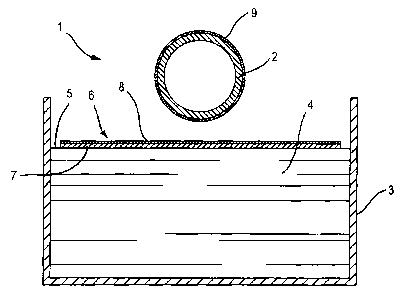Some of the information on this Web page has been provided by external sources. The Government of Canada is not responsible for the accuracy, reliability or currency of the information supplied by external sources. Users wishing to rely upon this information should consult directly with the source of the information. Content provided by external sources is not subject to official languages, privacy and accessibility requirements.
Any discrepancies in the text and image of the Claims and Abstract are due to differing posting times. Text of the Claims and Abstract are posted:
| (12) Patent: | (11) CA 2511791 |
|---|---|
| (54) English Title: | METHOD FOR DECORATING OBJECTS USING A TRANSFERABLE-INK IMAGE |
| (54) French Title: | PROCEDE DE DECORATION D'OBJETS AU MOYEN D'UNE IMAGE D'ENCRE TRANSFERABLE |
| Status: | Granted and Issued |
| (51) International Patent Classification (IPC): |
|
|---|---|
| (72) Inventors : |
|
| (73) Owners : |
|
| (71) Applicants : |
|
| (74) Agent: | SMART & BIGGAR LP |
| (74) Associate agent: | |
| (45) Issued: | 2013-05-14 |
| (22) Filed Date: | 2005-07-11 |
| (41) Open to Public Inspection: | 2007-01-11 |
| Examination requested: | 2010-06-17 |
| Availability of licence: | N/A |
| Dedicated to the Public: | N/A |
| (25) Language of filing: | English |
| Patent Cooperation Treaty (PCT): | No |
|---|
| (30) Application Priority Data: | None |
|---|
A method for decorating an object (2) comprises positioning on the surface (5) of a solvent (4) a transfer film (6) provided with a soluble layer (7) associated with a decorative layer (8) of sublimable inks, and immersing said object (2) in said solvent (4) so that said decorative layer (8) remains associated with said object (2), said decorative layer (8) being in direct contact with said soluble layer (7) in said transfer film (6).
Une méthode de décoration d'un objet (2) comprend le positionnement sur la surface (5) d'un solvant (4) d'une pellicule de transfert (6) comportant une couche soluble (7) associée à une couche décorative (8) d'encres sublimables, et l'immersion dudit objet (2) dans ledit solvant (4) de sorte que ladite couche décorative (8) reste associée audit objet (2), ladite couche décorative (8) étant en contact direct avec ladite couche soluble (7) de ladite pellicule de transfert (6).
Note: Claims are shown in the official language in which they were submitted.
Note: Descriptions are shown in the official language in which they were submitted.

2024-08-01:As part of the Next Generation Patents (NGP) transition, the Canadian Patents Database (CPD) now contains a more detailed Event History, which replicates the Event Log of our new back-office solution.
Please note that "Inactive:" events refers to events no longer in use in our new back-office solution.
For a clearer understanding of the status of the application/patent presented on this page, the site Disclaimer , as well as the definitions for Patent , Event History , Maintenance Fee and Payment History should be consulted.
| Description | Date |
|---|---|
| Inactive: COVID 19 - Deadline extended | 2020-07-02 |
| Change of Address or Method of Correspondence Request Received | 2019-11-20 |
| Common Representative Appointed | 2019-10-30 |
| Common Representative Appointed | 2019-10-30 |
| Inactive: Cover page published | 2013-09-26 |
| Inactive: Acknowledgment of s.8 Act correction | 2013-09-24 |
| Correction Request for a Granted Patent | 2013-09-20 |
| Grant by Issuance | 2013-05-14 |
| Inactive: Cover page published | 2013-05-13 |
| Pre-grant | 2013-02-22 |
| Inactive: Final fee received | 2013-02-22 |
| Notice of Allowance is Issued | 2012-10-09 |
| Letter Sent | 2012-10-09 |
| Notice of Allowance is Issued | 2012-10-09 |
| Inactive: Approved for allowance (AFA) | 2012-10-05 |
| Amendment Received - Voluntary Amendment | 2012-07-30 |
| Inactive: S.30(2) Rules - Examiner requisition | 2012-01-30 |
| Letter Sent | 2011-02-15 |
| Inactive: Multiple transfers | 2011-01-26 |
| Letter Sent | 2010-06-25 |
| Request for Examination Requirements Determined Compliant | 2010-06-17 |
| All Requirements for Examination Determined Compliant | 2010-06-17 |
| Request for Examination Received | 2010-06-17 |
| Application Published (Open to Public Inspection) | 2007-01-11 |
| Inactive: Cover page published | 2007-01-10 |
| Inactive: IPC assigned | 2006-05-03 |
| Inactive: IPC assigned | 2006-05-03 |
| Inactive: IPC assigned | 2006-05-02 |
| Inactive: First IPC assigned | 2006-05-02 |
| Letter Sent | 2005-09-29 |
| Inactive: Single transfer | 2005-09-09 |
| Inactive: Courtesy letter - Evidence | 2005-08-30 |
| Inactive: Filing certificate - No RFE (English) | 2005-08-23 |
| Filing Requirements Determined Compliant | 2005-08-23 |
| Application Received - Regular National | 2005-08-19 |
There is no abandonment history.
The last payment was received on 2012-06-22
Note : If the full payment has not been received on or before the date indicated, a further fee may be required which may be one of the following
Please refer to the CIPO Patent Fees web page to see all current fee amounts.
Note: Records showing the ownership history in alphabetical order.
| Current Owners on Record |
|---|
| DECORAL SYSTEM USA CORP. |
| Past Owners on Record |
|---|
| GIANCARLO FENZI |